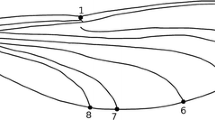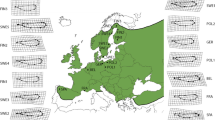Abstract
Comparing species differences in covariance patterns of traits subject to divergent selection pressures can increase our understanding to the mechanisms of phenotypic divergence. Different species of calopterygid damselflies have diverged in the melanized wing patch of males. This trait serves multiple ecological functions and has behavioral consequences in terms of sexual selection, interspecific interactions, reproductive isolation. We compared the phenotypic variance-covariance matrices (P) of wing traits among nine populations of four European species of calopterygid damselflies. We found modest divergence in covariance structure among populations of the same species, but strong divergence between species. Interestingly, the orientation of the first eigenvector of P (P max ) differed more between closely related species than between distantly related species, although this pattern was absent when overall covariance structures were compared. We also found that distantly related species but geographically closer had converged towards a similar covariance structure. Finally, divergence in covariance structure was correlated with divergence in wing patch length, but not with other wing traits. This last finding suggests that divergent selection on wing patch length might have affected the stability of P. These results indicate that P might not only reflect ancestral developmental pathways but might also be influenced by current ecology.




Similar content being viewed by others
References
Arnold, S. J. (1992). Constraints on phenotypic evolution. American Naturalist, 140, S85–S107. doi:10.1086/285398.
Arnold, S. J., Burger, R., Holenhole, P. A., Beverley, C. A., & Jones, A. G. (2008). Understanding the evolution and stability of the G-matrix. Evolution; International Journal of Organic Evolution, 62, 2451–2461. doi:10.1111/j.1558-5646.2008.00472.x.
Arnold, S. J., Pfrender, M. E., & Jones, A. G. (2001). The adaptive landscape as a conceptual bridge between micro- and macroevolution. Genetica, 112–113, 9–32. doi:10.1023/A:1013373907708.
Askew, R. R. (1988). The dragonflies of Europe. Colchester, UK: Harley books.
Beldade, P., Koops, K., & Brakefield, P. M. (2002). Developmental constraints versus flexibility in morphological evolution. Nature, 416, 844–847. doi:10.1038/416844a.
Cheverud, J. M. (1984). Quantitative genetics and developmental constraints on evolution by selection. Journal of Theoretical Biology, 110, 155–172. doi:10.1016/S0022-5193(84)80050-8.
Cheverud, J. M. (1996). Quantitative genetic analysis of cranial morphology in the cotton-top (Saguinus oedipus) and saddle-back (S. fuscicollis) tamarins. Journal of Evolutionary Biology, 9, 5–42. doi:10.1046/j.1420-9101.1996.9010005.x.
Clusella-Trullas, S., van Wyk, J. H., & Spotila, J. R. (2007). Thermal melanism in ectotherms. Journal of Thermal Biology, 32, 235–245. doi:10.1016/j.jtherbio.2007.01.013.
Corbet, P. S. (1999). Dragonflies: Behaviour and ecology of Odonata. Colchester, UK: Harley Books.
Córdoba-Aguilar, A., & Cordero-Rivera, A. (2005). Evolution and ecology of Calopterygidae (Zygoptera: Odonata): Status of knowledge and research perspectives. Neotropical Entomology, 34, 861–879. doi:10.1590/S1519-566X2005000600001.
Debat, V., Begin, M., Legout, H., & David, J. R. (2003). Allometric and nonallometric components of Drosophila wing shape respond differently to developmental temperature. Evolution; International Journal of Organic Evolution, 57, 2773–2784.
Debat, V., & David, P. (2001). Mapping phenotypes: canalization, plasticity and developmental stability. Trends in Ecology & Evolution, 16, 555–561. doi:10.1016/S0169-5347(01)02266-2.
Debat, V., Milton, C. C., Rutherford, S., Klingenberg, C. P., & Hoffmann, A. A. (2006). Hsp90 and the quantitative variation of wing shape in Drosophila melanogaster. Evolution; International Journal of Organic Evolution, 60, 2529–2538.
Dumont, H. J., Mertens, J., & De Coster, W. (1993). The Calopteryx-splendens-cline in southwestern France, analysed by quantitative wingspot analysis (Zygoptera: Calopterygidae). Odonatologica, 22, 345–351.
Dumont, H. J., Vanfleteren, J. R., De Jonckheere, J. F., & Weekers, P. H. H. (2005). Phylogenetic relationships, divergence time estimation, and global biogeographic patterns of calopterygoid damselflies (Odonata, Zygoptera) inferred from ribosomal DNA sequences. Systematic Biology, 54, 347–362. doi:10.1080/10635150590949869.
Eroukhmanoff, F., & Svensson, E. I. (2008). Phenotypic integration and conserved covariance structure in calopterygid damselflies. Journal of Evolutionary Biology, 21, 514–526. doi:10.1111/j.1420-9101.2007.01488.x.
Frankino, W. A., Zwaan, B. J., Stern, D. L., & Brakefield, P. M. (2005). Natural selection and developmental constraints in the evolution of allometries. Science, 307, 718–720. doi:10.1126/science.1105409.
Funk, D. J., Nosil, P., & Etges, W. J. (2006). Ecological divergence exhibits consistently positive associations with reproductive isolation across disparate taxa. Proceedings of the National Academy of Sciences of the United States of America, 103, 3209–3213. doi:10.1073/pnas.0508653103.
Game, E. T., & Caley, M. J. (2006). The stability of P in coral reef fishes. Evolution; International Journal of Organic Evolution, 60, 814–823.
Goodin, J. T., & Johnson, M. S. (1992). Patterns of morphological covariation in Partula. Systematic Biology, 41, 292–304. doi:10.2307/2992568.
Hedenstrom, A., & Rosen, M. (2001). Predator versus prey: On aerial hunting and escape strategies in birds. Behavioral Ecology, 12, 150–156. doi:10.1093/beheco/12.2.150.
Huey, R. B., Gilchrist, G. W., Carlson, M. L., Berrigan, D., & Serra, L. (2000). Rapid evolution of a geographic cline in size in an introduced fly. Science, 287, 308–309. doi:10.1126/science.287.5451.308.
Jamniczky, H. A., & Hallgrimsson, B. (2009). A comparison of covariance structure of wild and laboratory muroid crania. Evolution: International Journal of Organic Evolution. doi:10.1111/j.1558-5646.2009.00651.x.
Marden, J. H. (2008). Dragonfly flight performance: a model system for biomechanics, physiological genetics, and animal competitive behaviour, Chap. 19, pp. 249–259. In A. Córdoba-Aguilar (Ed.), Dragonflies and damselflies: Model organisms for ecological and evolutionary research. Oxford: Oxford University Press.
Maynard Smith, J., Burian, R., Kauffman, S., Alberch, P., Campbell, J., Goodwin, B., et al. (1985). Developmental constraints and evolution: A perspective from the mountain lake conference on development and evolution. Quarterly Review of Biology, 60, 265–287.
McGhee, G. R. (1999). Theoretical morphology: The concept and its applications. New York: Columbia University Press.
Nijhout, H. F. (2008). Developmental phenotypic landscapes. Evolutionary Biology, 35, 100–103. doi:10.1007/s11692-008-9024-9.
Pelabon, C., Hansen, T. F., Carter, A. J., & Houle, D. (2006). Response of fluctuating and directional asymmetry to selection on wing shape in Drosophila melanogaster. Journal of Evolutionary Biology, 19, 764–776. doi:10.1111/j.1420-9101.2005.01054.x.
Polly, P. D. (2008). Developmental dynamics and G-matrices: Can morphometric spaces be used to model phenotypic evolution? Evolutionary Biology, 35, 83–96. doi:10.1007/s11692-008-9020-0.
Revell, L. J. (2007). Skewers. Available via http://anolis.oeb.harvard.edu/~liam/programs/.
Riska, B. (1985). Group size factors and geographic variation of morphometric correlation. Evolution; International Journal of Organic Evolution, 39, 792–803. doi:10.2307/2408679.
Schluter, D. (1996). Adaptive radiation along genetic lines of least resistance. Evolution; International Journal of Organic Evolution, 50, 1766–1774. doi:10.2307/2410734.
Schluter, D. (2000). The ecology of adaptive radiation. New York: Oxford University Press Inc.
Simon, J. L. (2000). Resampling Stats 2000. Virginia: Resampling Stats.
Sinervo, B., & Svensson, E. (2002). Correlational selection and the evolution of genomic architecture. Heredity, 89, 329–338. doi:10.1038/sj.hdy.6800148.
Siva-Jothy, M. T. (1999). Male wing pigmentation may affect reproductive success via female choice in a calopterygid damselfly (Zygoptera). Behaviour, 136, 1365–1377. doi:10.1163/156853999500776.
Statsoft, Inc. STATISTICA [7]. (2004). Statsoft, I. Available at: www.statsoft.com.
Steppan, S. J. (1997). Phylogenetic analysis of phenotypic covariance structure. 2. Reconstructing matrix evolution. Evolution; International Journal of Organic Evolution, 51, 587–594. doi:10.2307/2411130.
Svensson, E. I., Eroukhmanoff, F., & Friberg, M. (2006). Effects of natural and sexual selection on adaptive population divergence and premating isolation in a damselfly. Evolution; International Journal of Organic Evolution, 60, 1242–1253.
Svensson, E. I., & Friberg, M. (2007). Selective predation on wing morphology in sympatric damselflies. American Naturalist, 170, 101–112.
Svensson, E. I., Karlsson, K., Friberg, M., & Eroukhmanoff, F. (2007). Gender differences in species recognition and the evolution of asymmetric sexual isolation. Current Biology, 17, 1943–1947. doi:10.1016/j.cub.2007.09.038.
Svensson, E. I., Kristoffersen, L., Oskarsson, K., & Bensch, S. (2004). Molecular population divergence and sexual selection on morphology in the banded demoiselle (Calopteryx splendens). Heredity, 93, 423–433. doi:10.1038/sj.hdy.6800519.
True, J. R., Edwards, K. A., Yamamoto, D., & Carroll, S. B. (1999). Drosophila wing melanin patterns form by vein-dependent elaboration of enzymatic prepatterns. Current Biology, 9, 1382–1391. doi:10.1016/S0960-9822(00)80083-4.
Tynkkynen, K., Rantala, M. J., & Suhonen, J. (2004). Interspecific aggression and character displacement in the damselfly Calopteryx splendens. Journal of Evolutionary Biology, 17, 759–767. doi:10.1111/j.1420-9101.2004.00733.x.
Usherwood, J. R., & Lehmann, F. (2008). Phasing of dragonfly wings can improve aerodynamic efficiency by removing swirl. Journal of the Royal Society, Interface, 5, 1303–1307. doi:10.1098/rsif.2008.0124.
Wagner, G. P., & Altenberg, L. (1996). Perspective: Complex adaptations and the evolution of evolvability. Evolution; International Journal of Organic Evolution, 50, 967–976. doi:10.2307/2410639.
Wagner, G. P., Booth, G., & Bagheri-Chaichian, H. (1997). A population genetic theory of canalization. Evolution; International Journal of Organic Evolution, 51, 329–347. doi:10.2307/2411105.
Wallace, A. (2009). The effect of development on the direction of evolution: Toward a twenty-first century consensus. Evolution & Development, 6, 282–288.
Weekers, P. H. H., De Jonckheere, J. F., & Dumont, H. J. (2001). Phylogenetic relationships inferred from ribosomal ITS sequences and biogeographic patterns in representatives of the genus Calopteryx (Insecta: Odonata) of the west mediterranean and adjacent west European zone. Molecular Phylogenetics and Evolution, 20, 89–99. doi:10.1006/mpev.2001.0947.
West-Eberhard, M. J. (2003). Developmental plasticity and evolution. New York: Oxford University Press Inc.
Willmore, K. E., Young, N. M., & Richtsmeier, J. T. (2007). Phenotypic variability: Its Components, measurement and underlying developmental processes. Evolutionary Biology, 34, 99–120. doi:10.1007/s11692-007-9008-1.
Wotton, R. J., & Newman, D. J. S. (2008). Evolution, diversification, and mechanics of dragonfly wings, Chap. 20, pp. 261–274. In A. Córdoba-Aguilar (Ed.), Dragonflies and damselflies Model organisms for ecological and evolutionary research. Oxford: Oxford University Press.
Zera, A. J. (2006). Evolution genetics of juvenile hormone and ecdysteroid regulation in Gryllus: A case study in the microevolution of endocrine regulation. Comparative Biochemistry and Physiology Part A: Molecular & Integrative Physiology, 144, 365–379. doi:10.1016/j.cbpa.2005.11.026.
Zera, A. J., Potts, J., & Kobus, K. (1998). The physiology of life-history trade-offs: Experimental analysis of a hormonally induced life-history trade-off in Gryllus assimilis. American Naturalist, 152, 7–23. doi:10.1086/286146.
Acknowledgments
We are grateful to S. Kuchta, T. Gosden and two anonymous referees for constructive criticisms on the early drafts of this manuscript. This study was financially supported by The Ecole Normale Supérieure (ENS) and The Royal Physiographic Society in Lund (KFS) to FE, by the Fundación para el Fomento en Asturias de la Invetigación Cientifica Aplicada y la Tecnología (FICYT) to DO and the Swedish Research Council (VR) and The Swedish Council for Environment, Agriculture, and Spatial Planning (FORMAS) to EIS.
Author information
Authors and Affiliations
Corresponding author
Rights and permissions
About this article
Cite this article
Eroukhmanoff, F., Outomuro, D., Ocharan, F.J. et al. Patterns of Phenotypic Divergence in Wing Covariance Structure of Calopterygid Damselflies. Evol Biol 36, 214–224 (2009). https://doi.org/10.1007/s11692-009-9057-8
Received:
Accepted:
Published:
Issue Date:
DOI: https://doi.org/10.1007/s11692-009-9057-8




